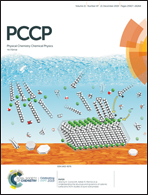Interfacial charge transfer enhancement via formation of binary molecular assemblies on electronically corrugated boron nitride†
Abstract
Using scanning tunneling microscopy/spectroscopy (STM/STS) in conjunction with finite element simulation, we investigate the interfacial behaviors in single-component zinc phthalocyanine (ZnPc) and hexadecafluorinated zinc phthalocyanine (F16ZnPc) molecular overlayers as well as their 1 : 1 mixed-phase superstructures on h-BN/Cu(111). We show that the formation of the binary molecular superstructure drastically increases the charge transfer between F16ZnPc molecules and the substrate, which is attributed to the greater electrostatic stability of the binary assembly compared to that of the pure phase. This study highlights the significant complication in the design of donor–acceptor molecular thin films as the presence of the substrate, even a weakly interacting one, such as h-BN/metal, can still perturb the intermolecular charge transfer and thereby the physical behaviors of the hybrid system via interfacial processes.



 Please wait while we load your content...
Please wait while we load your content...